Received: March 2023
DOI 10.17677/fn20714807.2023.02.04
Fluorine Notes, 2023, 147, 7-8
STUDY OF 2,6-DISUBSTITUTED POLYFLUOROALKYL-CONTAINING PHENOLS AND PRODUCTS OF THEIR SILYLATION BY GAS CHROMATOGRAPHY/MASS SPECTROMETRY
E.A. Khakina, V.I. Dyachenko
A.N. Nesmeyanov Institute of Organoelement Compounds RAS, Russian Federation, 119334, Moscow, Vavilov str. 28/1
Fax:+7 (499) 135 5085 E-mail: khakina90@ineos.ac.ru
Abstract: This communication is devoted to analysis of 2,6-disubstituted polyfluoroalkyl-containing phenols 1a-e and their derivatization (silylation) products - 2a-e by gas chromatography/mass spectrometry. It has been shown that intensities of molecular ions of compounds 1a-e depend on the nature of substituents in the ortho positions with respect to the hydroxy group. It was established that the mechanism of fragmentation of molecular ions of phenol 1е with tert-butyl substituents and its silyl ether differs from the mechanism of fragmentation of ions of other studied phenols, which is probably due to stability of tertiary carbocation formed during this process.
Keywords: gas chromatography/mass spectrometry, derivatization, polyfluoroalkyl-containing phenols.
The industrial use of polyfluorinated compounds has expanded exponentially. Currently, it are used in more than 200 different areas, including production of polymeric materials, hydrophobic coatings, pharmaceuticals and much more [1].
More than 9000 fluorinated compounds have been synthesized for commercial use [2]. Polyfluorinated compounds are now ubiquitous in the environment, and their toxicity to humans and ecosystems is now well documented [3-5]. Relatively recently, it has been shown that negative impact of exposure to polyfluorinated compounds on the human body includes more severe disease progression after infection with COVID-19 [6]. Due to adverse impact of perfluorinated compounds on the environment, methods for their determination and detection in various substances are being actively developed [7]. Gas chromatography/mass spectrometry with electron ionization is one of the most effective analytical methods for volatile thermally stable compounds [8]. NIST libraries, which summarize the spectral data for a large number of compounds of various classes, make it possible to efficiently identify the components of mixtures. In addition, the active development of derivatization methods expands the limits of applicability of gas chromatography/mass spectrometry [9].
However, these NIST libraries do not provide mass spectral data for all polyfluorinated compounds obtained to date.
In this paper, we studied a number of polyfluoroalkyl-containing phenols by gas chromatography/mass spectrometry (with and without derivatization) to reveal the dependence of fragmentation patterns on composition and structure. Studied objects were 2,6-disubstituted 4-(1,1,1,3,3,3-hexafluoro-2-hydroxypropan-2-yl)phenols 1а-е, differing in composition of substituents in aromatic nucleus (located in ortho positions relative to the hydroxy group, see Fig. 1).

Figure 1. 2,6-disubstituted 4-(1,1,1,3,3,3-hexafluoro-2-hydroxypropan-2-yl)phenols.
These compounds were synthesized by us by reaction of regioselective C hydroxyalkylation of phenols with hexafluoroacetone in the presence of N-nucleophiles as catalysts according to previously described procedures [10–11]. However, the mass spectra of these compounds obtained by electron ionization with an explanation of fragmentation could not be found in the literature.
Analysis was performed via Shimadzu GCMS QP2020 gas chromato-mass spectrometer using SH‑RTx-5MS column (30 m × 0.25 mm × 0.25 μm), electron ionization method and single quadrupole detector, that record the total ion current of positive ions. As a carrier gas was used helium (99.9999%). The analysis parameters are shown in Table 1. The registration was carried out in the mode of positive ion scanning in the range of 50-650 m/z. To prepare samples, a sample weighing 0.1 mg was dissolved in 1 ml of ethyl acetate. The results obtained were analyzed using GCMSolution program.
Table 1. GC/MS analysis parameters.
|
Initial temperature and hold time |
50°C, 1 min |
|
Heating rate |
30°C/min up to 290°C |
|
Hold time at final temperature |
3 min |
|
Total analysis time |
15 min |
|
Injector temperature |
250°C |
|
Injector mode |
Split (1:10) |
|
Sample volume |
0.1 µl |
|
Helium flow rate through the column |
1 ml/min |
|
Ion source temperature |
200°C |
|
Interface temperature |
250°C |
|
Electron energy |
70 eV |
As can be seen from Fig. 2, in spectra of phenols 1a-e under indicated ionization conditions, rather intense signals of molecular ions are observed. The intensity of these signals of molecular ions increases in the presence of substituent in 2,6 positions with respect to hydroxy group. An exception is phenol 1e, which contains two tert-butyl groups at 2,6-positions of aromatic nucleus. In mass spectrum of phenol 1е, the signal of molecular ion with relative intensity of 19% is observed, intensity of which is almost two times less than intensity of corresponding signal in spectrum of compound 1a,thatdoes not contain substituents in ortho positions with respect to hydroxy group. It is also worth noting that fragmentation path of phenol molecular ion 1e differs from fragmentation path of phenols 1a-d. The main path of fragmentation of molecular ions of studied polyfluorinated phenols 1a-d consists in initial removal of fluorine atom followed by release of difluorocarbene, which is a common mechanism for fragmentation of fluorinated compounds [12]. The subsequent fragmentation is accompanied by removal of proton along with fluorine atom and difluorocarbene. The molecular ion of phenol1е fragments according to another mechanism, consisting in removal of methyl radical and formation of a tertiary stable carbocation. Apparently, the stability of tertiary carbocation formed in this path is the reason for occurrence of fragmentation according to this mechanism.
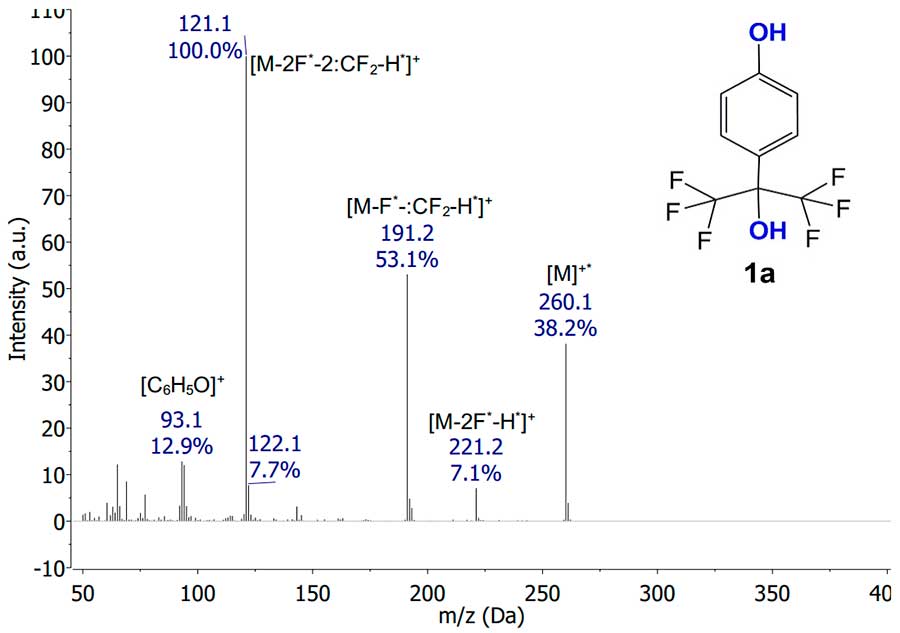
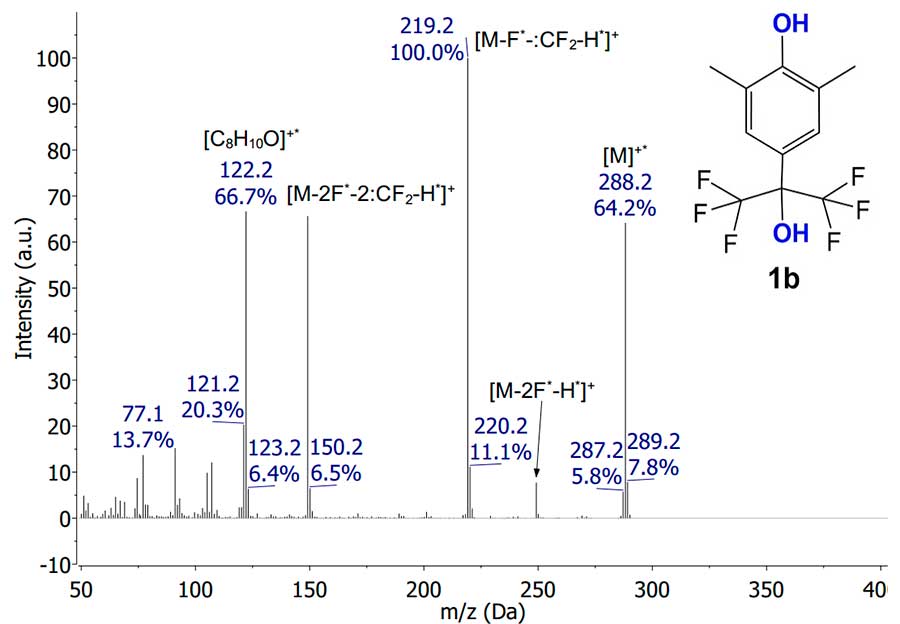
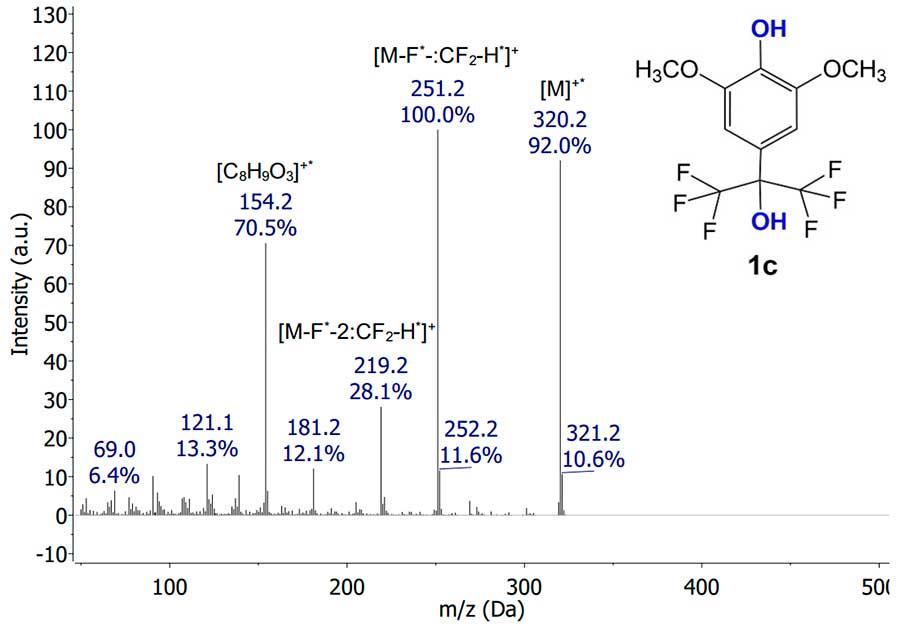
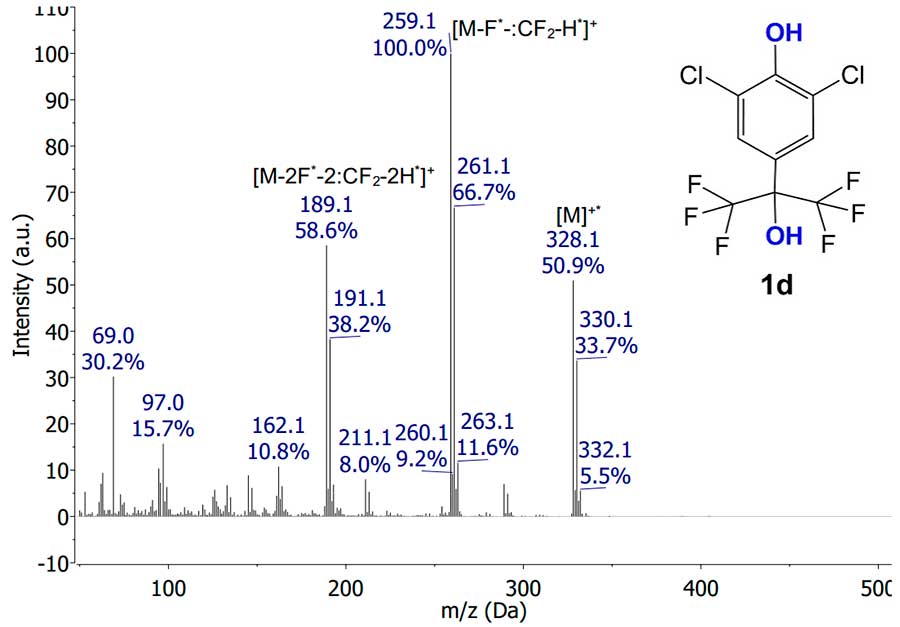
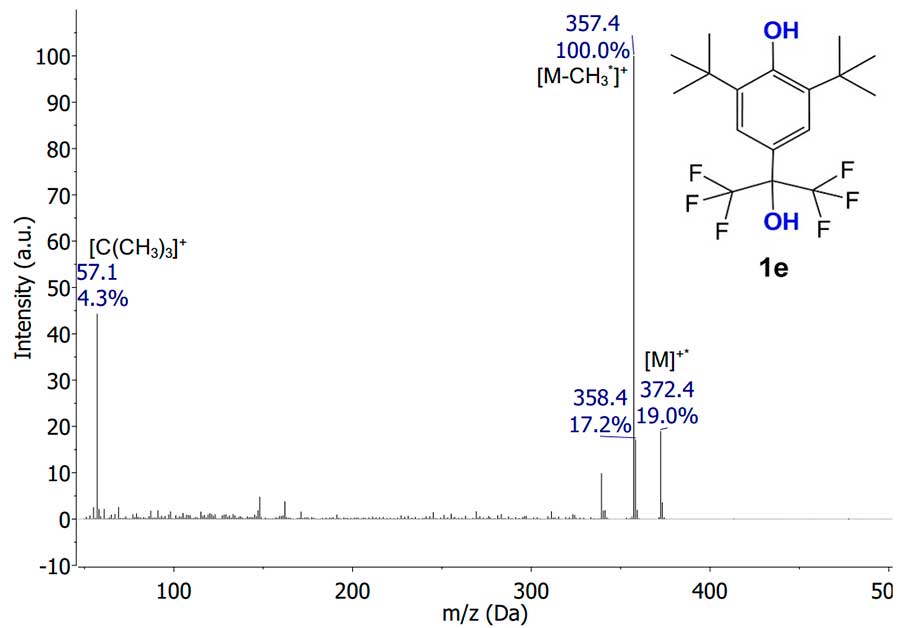
Figure 2. Mass spectra of compounds 1a-e obtained by electron ionization.
Fig. 3 shows a comparison of relative intensity of molecular ions obtained by electron ionization of phenols 1a-e, depending on the nature of substituents in aromatic nucleus. It should be noted that signal intensity increases in the series tert-Bu < H < Cl < Me < OMe. The lowest molecular ion intensity obtained for compounds with tert-butyl groups is probably due to the stability of tertiary carbocation formed during its fragmentation.

Figure 3. Relative intensity of molecular ions in mass spectra compounds 1a-e.
For derivatization, 1-(trimethylsilyl)imidazole was used (see Scheme 1). Ethyl acetate was used as a solvent during derivatization. To a solution of 0.1 mg of compound 1a-e in 1 ml of dry ethyl acetate in a vial for chromatographic analysis was added 5 μl of derivatizing agent. The resulting mixture was boiled for 30 s, then cooled to room temperature and analyzed under the same conditions as for initial alcohols (see Table 1).
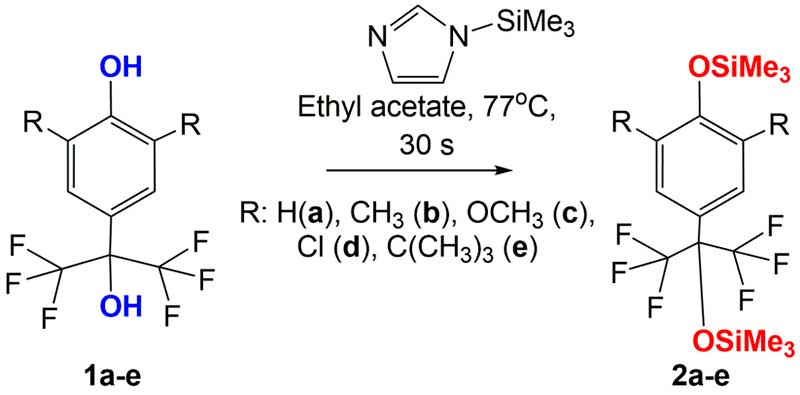
Scheme 1.
Reaction of studied phenols with a derivatizing agent under indicated conditions led to transformation of both alcohol groups into silyl ethers. In this case, due to increase in molecular weight of silyl ethers compared to the mass of initial phenols, their retention time under these separation conditions also increased. Table 2 summarizes the retention times of starting phenols and their silyl ethers.
Table 2. Retention times (tR) of phenols 1a-e and their silyl ethers under GC/MS analysis conditions
|
tR, min |
Compounds |
|||||||||
|
1а |
2a |
1b |
2b |
1c |
2c |
1d |
2d |
1e |
2e |
|
|
5,66 |
6,34 |
6,04 |
6,89 |
6,69 |
7,22 |
6,27 |
7,15 |
6,71 |
7,94 |
|
It should be noted that intensity of molecular ions signals in the electron ionization spectra of silyl ethers 2а-е is lower in comparison with intensity of corresponding ions of initial phenols (see Fig. 4). The first stage in fragmentation of molecular ions of studied silyl ethers is removal of methyl group, and the next stage of fragmentation is removal of fluorine atom, followed by release of difluorocarbene (by analogy with initial phenols).
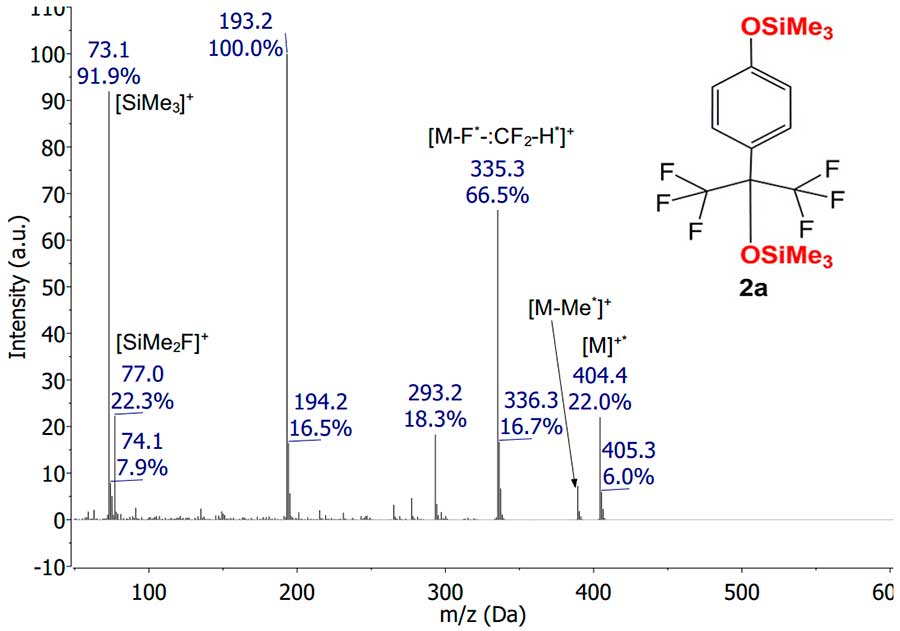
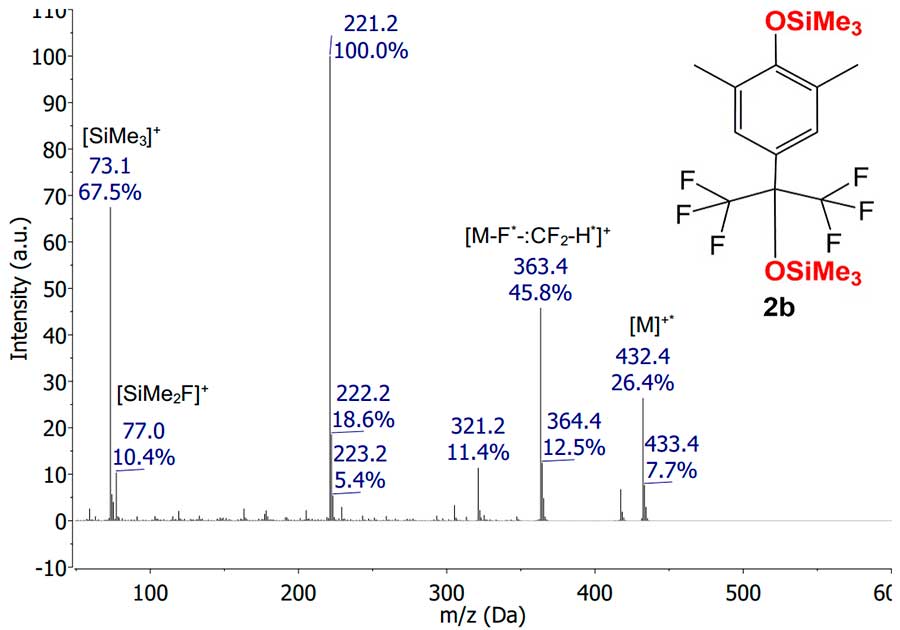
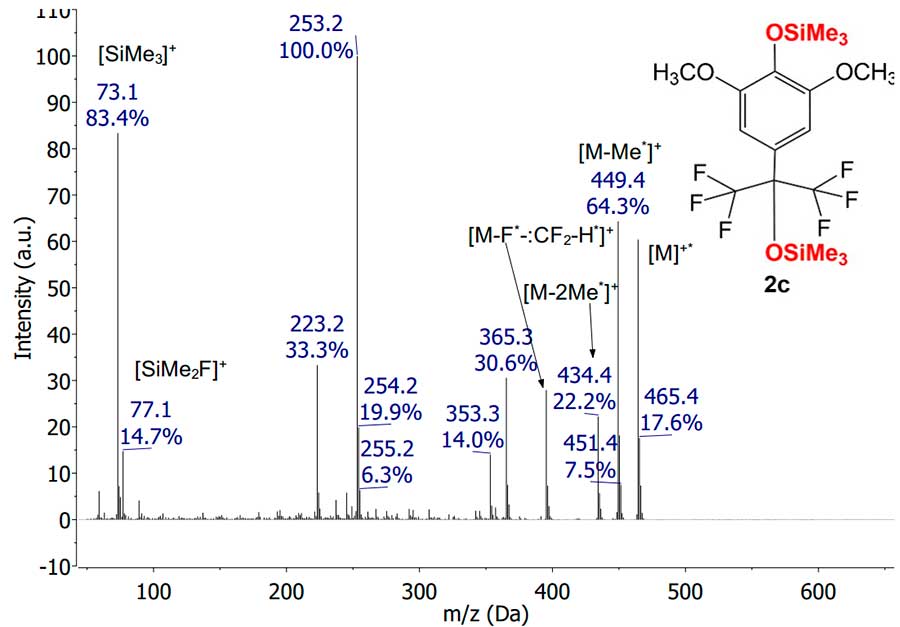
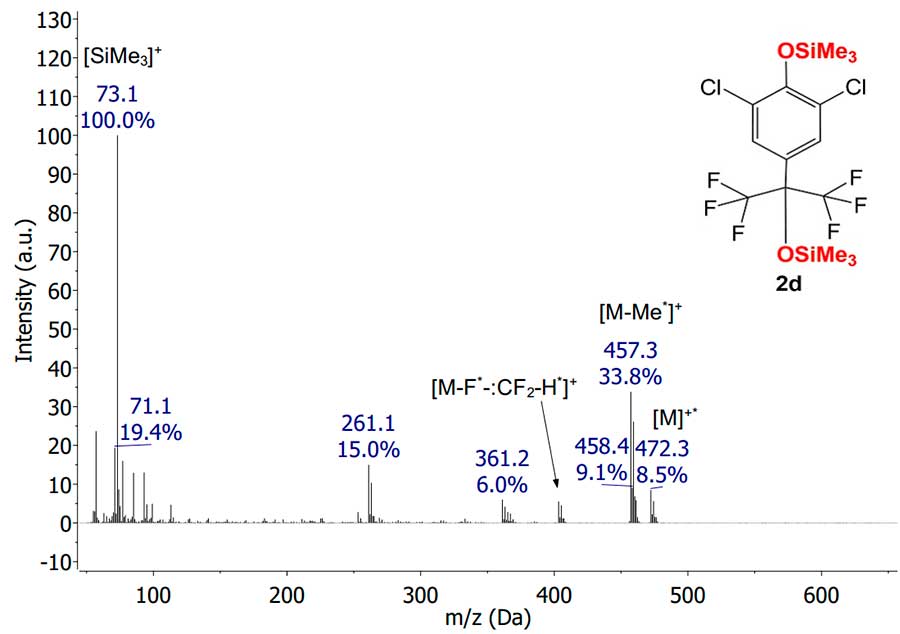
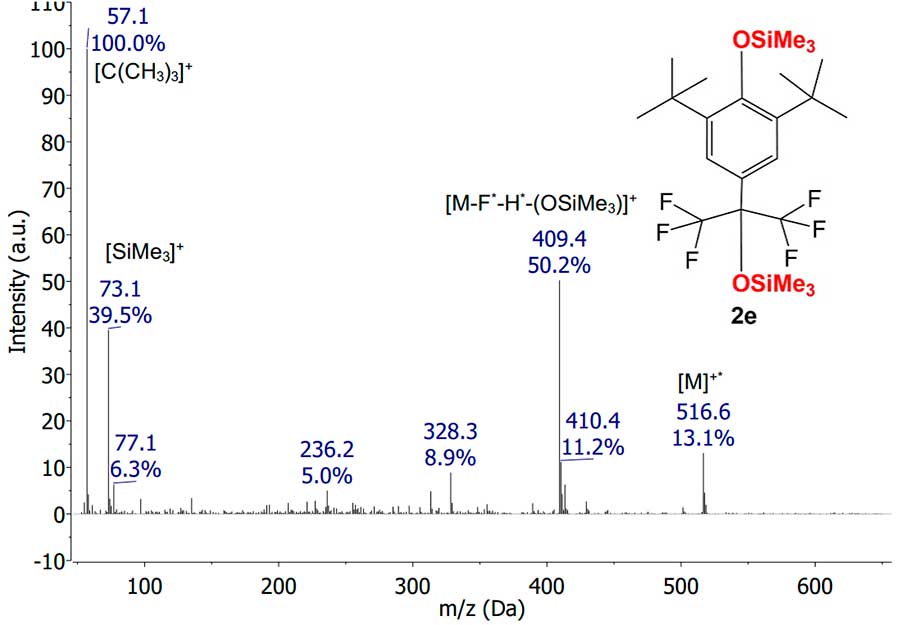
Figure 4. Mass spectra of compounds 2a-e obtained by electron impact ionization.
Interestingly, unlike the starting phenol 1e, its silyl ester 2e fragments according to a more complex mechanism. The first stage of its fragmentation is apparently accompanied by removal of methyl group or methane molecule with simultaneous release of fluorine radical and dimethylsilyl oxide.
Probably, the founded regularities of mass spectral fragmentation of 2,6-disubstituted 4-(1,1,1,3,3,3-hexafluoro-2-hydroxypropan-2-yl) phenols 1а-е and their trimethylsilyl ethers 2а-е can be characteristicfor other analogues containing other alkyl and alkoxy groups, aryl substituents, halogen atoms, etc.
Conclusions
2,6-Disubstituted 4-(1,1,1,3,3,3-hexafluoro-2-hydroxypropan-2-yl) phenols 1а-е and their silyl esters 2а-е were studied by gas chromatography/mass spectrometry. It was shown that derivatization of phenols 1а-е leads to addition of two silyl groups despite the potential steric hindrance caused by CF3 groups.
Dependence of molecular ion intensity for phenols 1а-е on the nature of the substituents in the ortho positions with respect to hydroxy group has been demonstrated. It was established that the mechanism of fragmentation of phenol molecular ion 1е and its derivatization product 2е differs from mechanisms of fragmentation of phenols 1а-d and their silyl ethers. Probably, this difference is caused by stability of tertiary carbocation formed during molecular ions fragmentation of phenol 1е and its silyl ether containing tert-butyl substituents in aromatic nucleus.
Acknowledgments
This work was financially supported by the Ministry of Science and Higher Education of Russian Federation within the framework of State Assignment No. 075-000697-22-03 using scientific equipment of the Center of Molecules Structure Study of INEOS RAS.
References
- Glüge J., Scheringer M., Cousins I.T., DeWitt J.C., Goldenman G., Herzke D. et al., An overview of the uses of per-and polyfluoroalkyl substances (PFAS), Environ. Sci. Process. Impact, 2020, 22, 2345.
- Hogue C., PFAS targeted in legislation passed by US House of Representatives, Chem. Eng. News, 2021.
- Rice P.A., Cooper J., Koh-Fallet S.E., Kabadi S.V., Comparative analysis of the physicochemical, toxicokinetic, and toxicological properties of ether-PFAS, Toxicol. Appl. Pharmacol., 2021, 422, 115531.
- Sinclair G.M., Long S.M., Jones O.A.H., What are the effects of PFAS exposure at environmentally relevant concentrations? Chemosphere, 2020, 258, 127340.
- Sunderland E.M., Hu X.C., Dassuncao C., Tokranov A.K., Wagner C.C., Allen, J.G., A review if the pathways of human exposure to poly- and perfluoroalkyl substances (PFASs) and present understanding of the health effects, J. Expo. Sci. Environ. Epidemiol., 2019, 29, 131.
- Grandjean P., Timmermann C.A.G., Kruse M., Nielsen F., Vinholt P.J., Boding L. et al., Severity of COVID-19 at elevated exposure to perfluorinated alkylates, PLoS One, 2020, 15, e0244815.
- Bisceglia K.J., Kroening G., Bikram S., ACS Symposium Series, 2019, 1319, 51.
- Mojiri A., Zhou J. L., Ohashi A., Ozaki N., Kindaichi T., Science of the Total Environment, 2019, 696, 133971.
- Harvey D. J., Vouros P., Mass Spectrometry Reviews, 2020, 39, 105.
- Dyachenko, V. I. et al., Bulletin of USSR Academy of Science, ser. Chemistry, 1989, 4, 923.
- Dyachenko, V. I. et al., J. Organic Chem., 1922, 28, 8, 1684.
- Kagramanov N.D., Fluorine notes, 2020, 1, 128, 3-4.
ARTICLE INFO
Received 17 March 2023
Accepted 20 April 2023
Available online April 2023
Recommended for publication by PhD O.V. Bryzgalova
eLIBRARY Document Number (EDN) LUOSCY

Fluorine Notes, 2023, 147, 7-8
